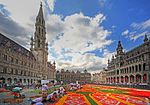Jeanneke Pis

Jeanneke Pis (Dutch: [ˌʒɑnəkə ˈpɪs]; Dutch for 'Little Pissing Joan') is a modern fountain sculpture in central Brussels, Belgium. It was commissioned by Denis-Adrien Debouvrie in 1985 and erected in 1987 as a counterpoint to the city's famous Manneken Pis. The 50-centimetre (20 in) bronze statue depicts a little girl with short pigtails, squatting and urinating on a blue-grey limestone base. Jeanneke Pis is located north of the Grand Place (Brussels' main square), on the eastern side of the Impasse de la Fidélité/Getrouwheidsgang, a narrow cul-de-sac some 30 metres (100 ft) long leading northwards off the restaurant-packed Rue des Bouchers/Beenhouwersstraat. The sculpture is now protected from vandalism by iron bars.
Excerpt from the Wikipedia article Jeanneke Pis (License: CC BY-SA 3.0, Authors, Images).Jeanneke Pis
Impasse de la Fidélité - Getrouwheidsgang, City of Brussels Pentagon (Brussels)
Geographical coordinates (GPS) Address Website Nearby Places Show on map
Geographical coordinates (GPS)
| Latitude | Longitude |
|---|---|
| N 50.848472222222 ° | E 4.3540277777778 ° |
Address
Floris Bar
Impasse de la Fidélité - Getrouwheidsgang
1000 City of Brussels, Pentagon (Brussels)
Belgium
Open on Google Maps











